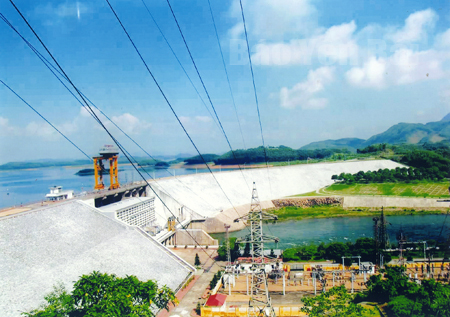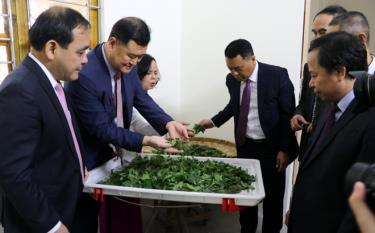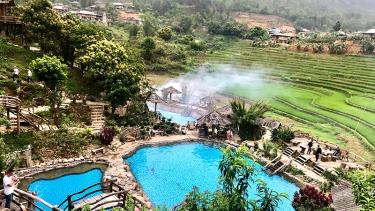1. Land resources
Yen Bai has a total natural land area of over 6,887 square kilometers. Of which, the agricultural and non-agricultural land areas are 587,879 ha and 53,724 ha, making up 85.35 percent and 7.81 percent, respectively. The unused land is 47,142 ha, equivalent to 6.84 percent. The forest coverage rate stands at over 62.9 percent, ranking second in the country (according to the 2018 data).
The locality has many types of soil suitable for growing wet rice, crops, yearly and perennial industrial trees; protection forests and special-use forests. Typical among those are alluvial soil - accounting for 1.33 percent of the natural land area, gray soil - 82.57 percent; red soil - 1.76 percent; and alum soil - 8.1 percent.
With more than 231,563 hectares of natural forest and 174,667 hectares of planted forest, Yen Bai has strength to develop the industry of processing wood and forest products. The timber output reaches nearly 459,050 cu.m, including acacia, bodhi, eucalyptus and over 120,000 tonnes of bamboo-family plants.
The total area of tea trees in the whole province is 7,820 ha, mainly in the districts of Van Chan (4,780 ha), Tran Yen (904 ha) and Yen Binh (762 ha), generating a fresh tea bud output of about 75,000 tonnes.
Yen Bai has the largest cinnamon planting area in the country with 67,500 ha, mainly in the districts of Van Yen (40,000 ha), Tran Yen (10,200 ha), Van Chan (5,000 ha). The quality of cinnamon here is among the best, and the annual output reaches over 9,000 tonnes of dry cinnamon bark.
Meanwhile, the province’s cassava area stands at over 12,000 hectares, with an output of nearly 240,000 tonnes per year, mainly in Van Yen and Yen Binh districts with respective areas of over 5,800ha and over 2,500ha.
With over 2,000 ha of pasture, and grass areas under forest canopy, the locality boasts a great advantage for breeding buffaloes, cows, goats and poultry.
2. Water resources
Yen Bai has three major systems of rivers and streams, including the Hong (Red) River, the Chay River and the Nam Kim Stream with a total length of 320km and a basin area of over 3,400sq.km.
The system of tributaries is fairly evenly distributed throughout the province. Because rivers and streams originate from high mountains, Yen Bai boasts great potential for supplying water for daily activities, and developing hydropower plants.
The Hong River section flowing through Yen Bai has a length of 100 km, with 48 tributaries (including four large canals: Thia, Hut, Lau and Lao), and a basin area of 2,700sq.km.
Meanwhile, the Chay River section running through the locality has a length of 95 km, with 32 tributaries and a catchment area of 2,200sq.km.
Thac Ba hydroelectricity plant - the first of its kind in Vietnam was built in the downstream area of the Chay River.
The Nam Kim Stream - a tributary of the Da River - has a total area of 600sq.km. It has great potential for developing hydropower plants.
Yen Bai has 20,913ha of ponds and lakes. Covering over 19,500ha of water surface, the Thac Ba Lake has great potential for tourism development, and aquaculture.
3. Forest resources
Yen Bai’s flora is very diverse, including many different species and families, with rare forest products, precious medicinal plants, and plants for producing paper.
According to the 2018 land yearbook, Yen Bai had 464,892ha of forest land, accounting for 67.5 percent of the natural land area.
Yen Bai planted 289,806 ha of production forest, making up 42.08 percent of the natural land area, mainly in areas growing material plants for producing paper in the districts of Yen Binh, Tran Yen, Luc Yen, Van Yen and Van Chan; and cinnamon planting areas Van Yen, Tran Yen, Van Chan, Yen Binh, and Luc Yen districts, and Yen Bai city.
The locality had 138,939 ha of protection forest, accounting for 20.17 percent of the natural land area, mainly in the Da River protection forest area (comprising the districts of Mu Cang Chai and Tram Tau, and part of Van Chan district); the Hong River protection forest area (including Tran Yen, Van Yen and Van Chan districts, and Yen Bai city); and the Chay River protection forest area (comprising Yen Binh and Luc Yen districts).
It had 36,147 ha of special-use forests, equivalent to 5.25 percent of the natural land area, concentrating in Mu Cang Chai and Van Yen districts.
4. Mineral resources
Yen Bai boasts many types of mineral resources which are distributed in 257 mines, mainly in the groups of energy, minerals for producing construction materials, industrial minerals, metal, and mineral water.
The locality’s white limestone reserves stands at 2.4 billion cu.m, while the reserves of metals with iron ore reach 200 million tonnes, alongside graphite ore, lead and zinc ores, original gold ore, and quartz.
With its large reserves of minerals for producing construction materials (450 million tonnes for producing construction materials and over 15 million tonnes of kaolin and feldspar), Yen Bai has great potential for the production of cement, paving stones and other construction materials.
Yenbai newspaper






